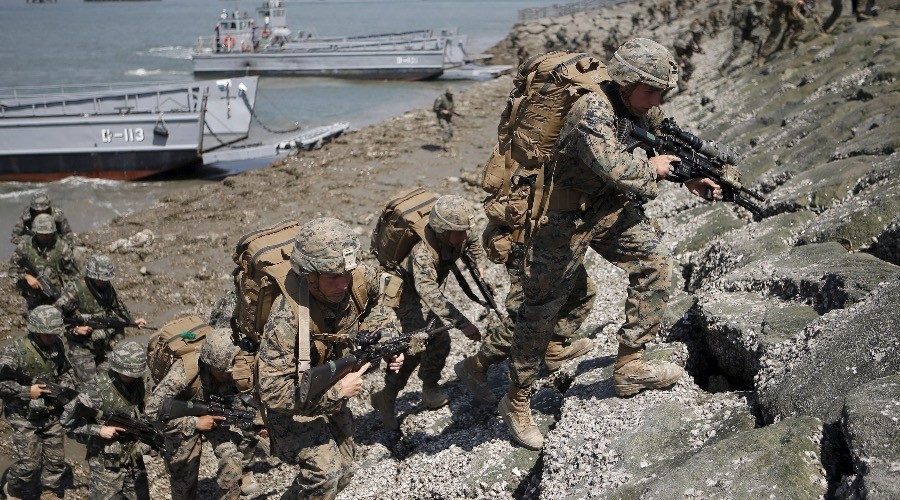
© Kim Hong-Ji / Reuters
Top US and South Korean military officials discussed "military options" in response to North Korea's latest test of what the Pentagon called an intercontinental ballistic missile. South Korea has requested additional missile defense units from the US.
Following Friday's launch, Marine General Joseph Dunford, chairman of the US Joint Chiefs of Staff, and head of the US Pacific Command Admiral Harry Harris called General Lee Sun-jin, chairman of the South Korean Joint Chiefs of Staff.
"During the call, Dunford and Harris expressed the ironclad commitment to the US - Republic of Korea alliance. The three leaders also discussed military response options," said a statement from the Pacific Command, confirmed to Reuters by Dunford's spokesman Captain Greg Hicks.US and South Korean militaries staged a "joint ballistic missile exercise" in response to the North Korean launch, South Korean news agency Yonhap reported.
The missile originated from Mupyong-ni, a weapons facility in the North Korean province of Jangang, around 11:40 pm local time Friday, the Pentagon said. It traveled for about 620 miles (997 km) before splashing down into the Sea of Japan.
"The North American Aerospace Defence Command (NORAD) determined the missile launch from North Korea did not pose a threat to North America," said Pentagon spokesman Captain Jeff Davis.
Japanese officials said the missile flew for 45 minutes and reached an altitude of more than 1,860 miles (nearly 3,000 km).
"As a result of their launches of ICBM-level missiles, this clearly shows the threat to our nation's safety is severe and real," Japanese Prime Minister Shinzo Abe said in a statement, adding that he would be convening Japan's National Security Council.
United Nations Secretary-General Antonio Guterres condemned North Korea's launch of a "ballistic missile of possible intercontinental range," his spokesman said on Friday.
The missile is believed to be the Hwasong-14, also known as the KN-20. Both North Korea and the US have described it as an ICBM, while the Russian military has described it as an intermediate-range (IRBM) weapon.
South Korean President Moon Jae-in has requested renewed talks with the US on deploying additional Terminal High Altitude Area Defense (THAAD) missile defense systems, his office announced.Moon was sworn into office in May, having triumphed in a snap election after his predecessor, Park Geun-hye, was impeached on corruption charges. He initially criticized the previous government's decision to host THAAD systems and announced he would
delay additional deployments until environmental concerns were addressed.
Before the July 4 test of the KN-20, US intelligence believed that North Korea wouldn't have long-range strike capability for four more years. New intelligence estimates, however, suggest the ICBM might have have the range to hit the West Coast of the US, and not just Alaska and Hawaii, the
Washington Free Beacon reported Wednesday.
"Time is running out" for diplomatic and political efforts to resolve the standoff with North Korea, US Army Chief of Staff General Mark Milley
warned on Wednesday, adding that there were "no good options" on the table but that a choice will have to be made.
On Tuesday, Pyongyang
threatened to "strike a merciless blow at the heart of the US with our powerful nuclear hammer," if Washington made any moves towards regime change in North Korea, after CIA Director Mike Pompeo made comments to that effect at a security forum in Colorado.
Reader Comments
This article is nothing but saber ratling by the U.S. in it's attempts to scare the living daylights out of the S.K.'s.
The FACTS, as they stand on the ground, are that no matter what bullshit the Americans come up with, no matter what invasion/bombing campaign they initiate, whatever happens, there's no way in hell, that the lives of millions of S'K.s willbe snuffed out as a direct result.
Of course, millions of N.K.'s will also be snuffed out as well, whilst the U.S. mainland stands untouched and their Government struts around beating it's chest telling the rest of the World how tough they are. Meanwhile, the Korean peninsular has been turned intoi a glass parking lot. Well done U.S. of A.
Could you see that on the CBC National News? LOL